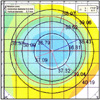1. Van Gelder RN, Steger-May K, Yang SH, et al. Comparison of photorefractive keratectomy, astigmatic PRK, laser in situ keratomileusis, and astigmatic LASIK in the treatment of myopia. J Cataract Refract Surg. 2002. 28:462–476.
2. Borish IM. Clinical Refraction. 1970. 3rd ed. Chicago: The Professional Press Inc.
3. Snibson GR, Carson CA, Aldred GF, Taylor HR. Melbourne Excimer Laser Group. One-year evaluation of excimer laser photorefractive keratectomy for myopia and myopic astigmatism. Arch Ophthalmol. 1995. 113:994–1000.
4. Taylor HR, Kelly P, Alpins N. Excimer laser correction of myopic astigmatism. J Cataract Refract Surg. 1994. 20:Suppl. 243–251.
5. Do KK, Lee DY, Park SJ. Clinical result of excimer laser photoastigmatic refractive keratectomy. J Korean Ophthalmol Soc. 1997. 38:7–16.
6. McDonnell PJ, Moreira H, Clapham TN, et al. Photorefractive keratectomy for astigmatism. Initial clinical results. Arch Ophthalmol. 1991. 109:1370–1373.
7. Stevens JD. Astigmatic excimer laser treatment: Theoretical effects of axis misalignment. Eur J Implant Refract Surg. 1994. 6:310–318.
8. Porter J, Yoon G, MacRae S, et al. Surgeon offsets and dynamic eye movements in laser refractive surgery. J Cataract Refract Surg. 2005. 31:2058–2066.
9. Asano-Kato N, Toda I, Sakai C, et al. Pupil decentration and iris tilting detected by Orbscan: anatomic variations among healthy subjects and influence on outcomes of laser refractive surgeries. J Cataract Refract Surg. 2005. 31:1938–1942.
10. Arbelaez MC, Vidal C, Arba-Mosquera S. Excimer laser correction of moderate to high astigmatism with a non-wavefront-guided aberration-free ablation profile: Six-month results. J Cataract Refract Surg. 2009. 35:1789–1798.
11. Lee SB, Hwang BS, Lee J. Effects of decentration of photorefractive keratectomy on the induction of higher order wavefront aberrations. J Refract Surg. 2010. 26:731–743.
12. Lee SB, Chung MS. Advanced surface ablation-photorefractive keratectomy (ASA-PRK): safety and clinical outcome for the correction of mild to moderate myopia with a thin cornea. J Korean Ophthalmol Soc. 2006. 47:1274–1286.
13. Mulhern MG, Foley-Nolan A, O'Keefe M, Condon PI. Topographical analysis of ablation centration after excimer laser photorefractive keratectomy and laser in situ keratomileusis for high myopia. J Cataract Refract Surg. 1997. 23:488–494.
14. Terrell J, Bechara SJ, Nesburn A, et al. The effect of globe fixation on ablation zone centration in photorefractive keratectomy. Am J Ophthalmol. 1995. 119:612–619.
15. Pande M, Hillman JS. Optical zone centration in keratorefractive surgery. Entrance pupil center, visual axis, coaxially sighted corneal reflex, or geometric corneal center? Ophthalmology. 1993. 100:1230–1237.
16. Bühren J, Yoon G, Kenner S, et al. The effect of optical zone decentration on lower- and higher-order aberrations after photorefractive keratectomy in a cat model. Invest Ophthalmol Vis Sci. 2007. 48:5806–5814.
17. Tsai YY, Lin JM. Ablation centration after active eye-tracker-assisted photorefractive keratectomy and laser in situ keratomileusis. J Cataract Refract Surg. 2000. 26:28–34.
18. Uozato H, Guyton DL. Centering corneal surgical procedures. Am J Ophthalmol. 1987. 103:264–275.
19. Arbelaez MC, Vidal C, Arba-Mosquera S. Clinical outcomes of corneal vertex versus central pupil references with aberration-free ablation strategies and LASIK. Invest Ophthalmol Vis Sci. 2008. 49:5287–5294.
20. Walsh G. The effect of mydriasis on the pupillary centration of the human eye. Ophthalmic Physiol Opt. 1988. 8:178–182.
21. Yang Y, Thompson K, Burns SA. Pupil location under mesopic, photopic, and pharmacologically dilated conditions. Invest Ophthalmol Vis Sci. 2002. 43:2508–2512.
22. Choi SH, Kim YS, Yim JH. Topographical analysis of ablation decentration between eye tracker-assisted and unassisted LASIK. J Korean Ophthalmol Soc. 2002. 43:650–657.
23. Bueeler M, Mrochen M. Limitations of pupil tracking in refractive surgery: systematic error in determination of corneal locations. J Refract Surg. 2004. 20:371–378.
24. Lee SB, Kim HK. Corneal topographic evaluation of centration of excimer laser myopic photorefractive keratectomy. J Korean Ophthalmol Soc. 1996. 37:934–944.
25. Webber SK, McGhee CN, Bryce IG. Decentration of photorefractive keratectomy ablation zones after excimer laser surgery for myopia. J Cataract Refract Surg. 1996. 22:299–303.
26. Lee JB, Jung JI, Chu YK, et al. Analysis of the factors affecting decentration in photorefractive keratectomy and laser in situ keratomileusis for myopia. Yonsei Med J. 1999. 40:221–225.
27. Lin DT, Sutton HF, Berman M. Corneal topography following excimer photorefractive keratectomy for myopia. J Cataract Refract Surg. 1993. 19:Suppl. 149–154.
28. Amano S, Tanaka S, Shimizu K. Topographical evaluation of centration of excimer laser myopic photorefractive keratectomy. J Cataract Refract Surg. 1994. 20:616–619.
29. Cavanaugh TB, Durrie DS, Riedel SM, et al. Topographical analysis of the centration of excimer laser photorefractive keratectomy. J Cataract Refract Surg. 1993. 19:Suppl. 136–143.
30. Wilson MA, Campbell MC, Simonet P. The Julius F. Neumueller Award in Optics, 1989: change of pupil centration with change of illumination and pupil size. Optom Vis Sci. 1992. 69:129–136.
31. Wyatt HJ. The form of the human pupil. Vision Res. 1995. 35:2021–2036.










 PDF
PDF ePub
ePub Citation
Citation Print
Print


 XML Download
XML Download